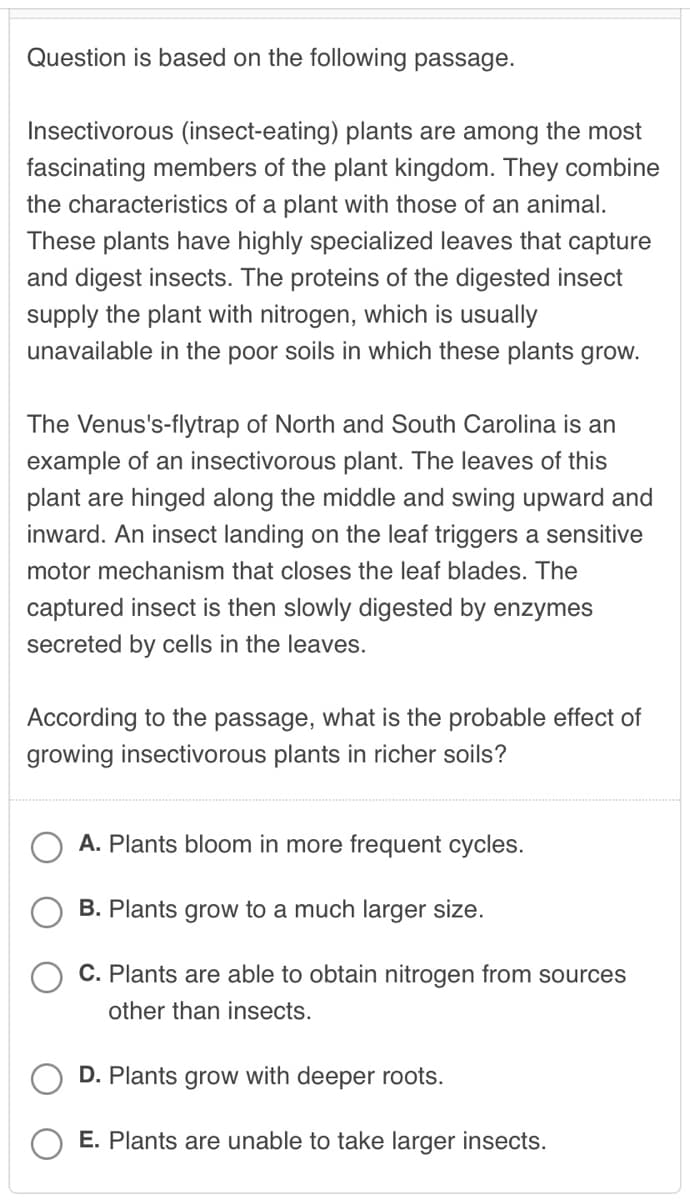According to the passage, what is the probable effect of growing insectivorous plants in richer soils? O A. Plants bloom in more frequent cycles. B. Plants grow to a much larger size. O C. Plants are able to obtain nitrogen from sources other than insects. OD. Plants grow with deeper roots. E. Plants are unable to take larger insects.
According to the passage, what is the probable effect of growing insectivorous plants in richer soils? O A. Plants bloom in more frequent cycles. B. Plants grow to a much larger size. O C. Plants are able to obtain nitrogen from sources other than insects. OD. Plants grow with deeper roots. E. Plants are unable to take larger insects.
Human Anatomy & Physiology (11th Edition)
11th Edition
ISBN:9780134580999
Author:Elaine N. Marieb, Katja N. Hoehn
Publisher:Elaine N. Marieb, Katja N. Hoehn
Chapter1: The Human Body: An Orientation
Section: Chapter Questions
Problem 1RQ: The correct sequence of levels forming the structural hierarchy is A. (a) organ, organ system,...
Related questions
Question

Transcribed Image Text:Question is based on the following passage.
Insectivorous (insect-eating) plants are among the most
fascinating members of the plant kingdom. They combine
the characteristics of a plant with those of an animal.
These plants have highly specialized leaves that capture
and digest insects. The proteins of the digested insect
supply the plant with nitrogen, which is usually
unavailable in the poor soils in which these plants grow.
The Venus's-flytrap of North and South Carolina is an
example of an insectivorous plant. The leaves of this
plant are hinged along the middle and swing upward and
inward. An insect landing on the leaf triggers a sensitive
motor mechanism that closes the leaf blades. The
captured insect is then slowly digested by enzymes
secreted by cells in the leaves.
According to the passage, what is the probable effect of
growing insectivorous plants in richer soils?
A. Plants bloom in more frequent cycles.
B. Plants grow to a much larger size.
C. Plants are able to obtain nitrogen from sources
other than insects.
D. Plants grow with deeper roots.
E. Plants are unable to take larger insects.
Expert Solution
This question has been solved!
Explore an expertly crafted, step-by-step solution for a thorough understanding of key concepts.
This is a popular solution!
Trending now
This is a popular solution!
Step by step
Solved in 2 steps

Knowledge Booster
Learn more about
Need a deep-dive on the concept behind this application? Look no further. Learn more about this topic, biology and related others by exploring similar questions and additional content below.Recommended textbooks for you

Human Anatomy & Physiology (11th Edition)
Biology
ISBN:
9780134580999
Author:
Elaine N. Marieb, Katja N. Hoehn
Publisher:
PEARSON

Biology 2e
Biology
ISBN:
9781947172517
Author:
Matthew Douglas, Jung Choi, Mary Ann Clark
Publisher:
OpenStax

Anatomy & Physiology
Biology
ISBN:
9781259398629
Author:
McKinley, Michael P., O'loughlin, Valerie Dean, Bidle, Theresa Stouter
Publisher:
Mcgraw Hill Education,

Human Anatomy & Physiology (11th Edition)
Biology
ISBN:
9780134580999
Author:
Elaine N. Marieb, Katja N. Hoehn
Publisher:
PEARSON

Biology 2e
Biology
ISBN:
9781947172517
Author:
Matthew Douglas, Jung Choi, Mary Ann Clark
Publisher:
OpenStax

Anatomy & Physiology
Biology
ISBN:
9781259398629
Author:
McKinley, Michael P., O'loughlin, Valerie Dean, Bidle, Theresa Stouter
Publisher:
Mcgraw Hill Education,

Molecular Biology of the Cell (Sixth Edition)
Biology
ISBN:
9780815344322
Author:
Bruce Alberts, Alexander D. Johnson, Julian Lewis, David Morgan, Martin Raff, Keith Roberts, Peter Walter
Publisher:
W. W. Norton & Company

Laboratory Manual For Human Anatomy & Physiology
Biology
ISBN:
9781260159363
Author:
Martin, Terry R., Prentice-craver, Cynthia
Publisher:
McGraw-Hill Publishing Co.

Inquiry Into Life (16th Edition)
Biology
ISBN:
9781260231700
Author:
Sylvia S. Mader, Michael Windelspecht
Publisher:
McGraw Hill Education